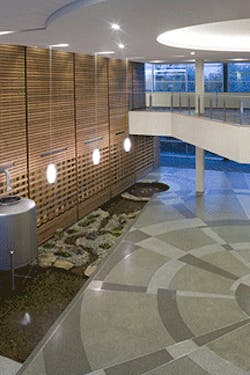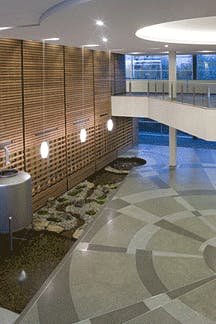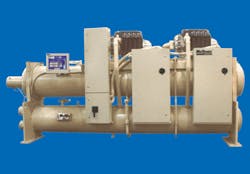Johnson County (Kansas) goes "green" to win LEED® gold
The Sunset Drive Office Building in Olathe, Kansas, was designed from the beginning to have the smallest possible negative impact on the environment - and the largest possible positive impact on everyone who uses the building. In 2006, the building received Gold certification using the LEED®-New Construciton (NC) Version 2.1 program from the U.S. Green Building Council (USGBC) -a recognition that both goals have been achieved. The LEED (Leadership in Energy and Environmental Design) Green Building Rating system is a third-party verification system and guideline for measuring what constitutes a green building.
Two McQuay® frictionless centrifugal compressor chillers played a major role in achieving these goals. Because of their innovative design, the chillers help to save energy and the environment and earn significant LEED points. "The chillers gave us the efficiency we needed to achieve the project goals," said Katrina Gerber, engineer with BGR Consulting Engineers, Kansas City.
The building was designed from its inception to achieve LEED-NC Gold certification (it received a total of 43 points). According to Angrisano, the design team decided not to aim for the highest LEED-NC certification level - Platinum - in part because the community might not be ready to accept the additional front-end cost. "LEED-NC Gold was seen as a saleable return on investment. We decided to do the first step very, very well. Now, the general acclaim we've achieved with this building makes it look like a prudent first step. That provides momentum to strive for even higher levels as we move forward with other building projects in the county."
Saving energy with "mag-lev" chiller technology
The Sunset Drive Building was designed to save about 40 percent in energy costs compared to the baseline defined in ASHRAE 90.1, the nationally accepted baseline standard on energy performance. "We're tracking energy use very closely," said Angrisano. "Over the six months from May to October, 2006, the Sunset Drive Building has saved 57 percent on energy costs compared with the 15-year-old building across the street, which is also owned by the county. That building is typical of those constructed to the 90.1-standard. We're also comparing the Sunset Drive Building with another county building a few miles away, which is newer and more energy efficient than the one across the street. Compared to the newer building, the Sunset Drive Building has saved about 43 percent in energy costs over the same six months."
A major factor in achieving those impressive energy savings is the design of the air conditioning system. The Sunset Drive Building was awarded eight LEED points in the Energy and Atmosphere category, which is directly impacted by the energy efficiency of the HVAC system.
The McQuay frictionless chiller uses HFC-134a refrigerant, which has no ozone depletion potential and no phase-out schedule.
The key to the chiller's efficiency is the compressor's digitally-controlled magnetic bearing system, which replaces conventional lubricated bearings. When in use, the only moving part in the chiller - its drive shaft - is suspended in mid-air by a system of permanent magnets and electromagnets. Positioning signals received by the electromagnets hold the shaft precisely in position within a tolerance of 0.00005 inches. Shaft position is sampled and adjusted 10,000 times each second.
Frictionless benefits
The frictionless technology, which has previously been proven in aerospace applications, provides many additional benefits:
- Vibration and noise associated with other types of chillers are virtually eliminated. "You can have a normal-voice conversation right next to the chillers when they start up," said Angrisano.
- Because frictionless chillers require less power, they can be built with permanent-magnet motors that require zero extra current at start-up. As a result, the compressor in a frictionless chiller uses about five amps to start, compared with 500 - 600 amps for a typical screw compressor with an electromagnet-driven motor.
- Frictionless chiller units are much more compact, take up less floor space, and can be delivered through a standard 3-foot door.
- No oil is needed to lubricate the bearings so there are no oil pumps, filters, coolers, or heaters - and there is no need to dispose of used oil. Only a small amount of oil is used to lubricate other system components, such as seals and valves. All of this saves on maintenance and reduces the chiller's weight and the space needed to house it.
Quality for the long haul
When asked what he wishes more people understood about "green" building, Angrisano said, "I hope people will understand that we're designing for the long term. One of the most harmful things is designing and constructing buildings for the short term. The last thing you want to do is end up with the building itself in a landfill in 40 years because it has outlived its usefulness or become too expensive to operate." Designing for the long term has put the Sunset Drive Office Building on the rise in terms of environmental stewardship and energy efficiency.


